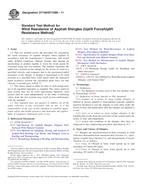Potřebujeme váš souhlas k využití jednotlivých dat, aby se vám mimo jiné mohly ukazovat informace týkající se vašich zájmů. Souhlas udělíte kliknutím na tlačítko „OK“.
ASTM D7158/D7158M-11
Standard Test Method for Wind Resistance of Asphalt Shingles (Uplift Force/Uplift Resistance Method)
Automaticky přeložený název:
Standardní zkušební metoda pro odolnost vůči větru asfaltových šindelů (vztlakové síly / Zdvih odporová metoda)
NORMA vydána dne 1.1.2011
Informace o normě:
Označení normy: ASTM D7158/D7158M-11
Poznámka: NEPLATNÁ
Datum vydání normy: 1.1.2011
Kód zboží: NS-37719
Počet stran: 16
Přibližná hmotnost: 48 g (0.11 liber)
Země: Americká technická norma
Kategorie: Technické normy ASTM
Kategorie - podobné normy:
Anotace textu normy ASTM D7158/D7158M-11 :
Keywords:
asphalt shingles, calculated wind resistance, factory-applied sealant, fan-induced wind, field-applied sealant, roofing, sealant bond strength, shingle mechanical uplift resistance, shingle uplift pressure coefficients, shingle uplift rigidity, wind resistance, wind uplift force, Shingles, Uplift resistance, Wind resistance, Asphalt shingles, ICS Number Code 91.060.20 (Roofs)
Doplňující informace
| Significance and Use | ||||||||||||
|
The wind resistance of sealed asphalt shingles is directly related to the ability of the sealed shingle to resist the force of the wind acting to lift the shingle from the shingle below. This test method employs the measured resistance of the shingle to mechanical uplift after sealing under defined conditions, in a calculation which determines whether this resistance exceeds the calculated force induced by wind passing over the surface of the shingle. Natural wind conditions differ with respect to intensity, duration, and turbulence; while these conditions were considered, and safety factors introduced, extreme natural variations are beyond the means of this test method to simulate. Many factors influence the sealing characteristics of shingles in the field; for example, temperature, time, roof slope, contamination by dirt and debris, and fasteners that are misaligned or under driven and interfere with sealing. It is beyond the scope of this test method to address all of these influences. The classification determined in this test method is based on the mechanical uplift resistance determined when representative samples of shingles are sealed under defined conditions before testing. The calculations that support the Classes in 4.1 use several standard building environment factors. These include the 3-s wind gust exposure from ASCE-7, installation on Category I or II buildings for all slopes, ground roughness B or C, and installation on buildings 60 ft tall or less. Note 2—The assumptions used in the calculations for the classes in 4.1 cover the requirements for the majority of the asphalt shingle roofs installed. If environmental factors are outside those used in the calculations for these classes, such as ground roughness D, building heights greater than 60 ft tall, building use categories III or IV and other exposures as defined by ASCE-7, other calculations are required. Consult the shingle manufacturer for the specific shingle’s DCp, EI, L, L1, and L2 values needed to complete these calculations. The test to determine uplift coefficients is conducted with a wind velocity of 15.6 ± 1.3 m/s [35 ± 3 mph]. Research data obtained during the development of this test procedure, as well as standard wind modeling practices, provides for data extrapolation to other wind speeds. In order to simulate the raised shingle edge that is inherent behavior under high wind exposure, shims are inserted under the windward edge of the shingle as appropriate based on wind speed and uplift rigidity of the shingle being investigated. This test method provides a means of measuring shingle uplift rigidity which is used to determine the correct shim thickness. Additionally, this test method allows for the use of a default value for uplift rigidity (EI) of 7175 N-mm2 [2.5 lbf-in.2], if a rigidity measurement is not made. This default value is conservative since the lowest EI measured in the development of this program was 14 350 N-mm2 [5.0 lbf-in.2]. Note 3— The entire field of wind engineering is based on use of small-scale models in wind tunnels using wind speeds much lower than the full-scale values. Building Codes permit testing of this type to replace the analytical provisions of the Building Code through the provisions of ASCE 7. (See Appendix X1 for details and references.) |
||||||||||||
| 1. Scope | ||||||||||||
|
1.1 This test method covers the procedure for calculating the wind resistance of asphalt shingles when applied in accordance with the manufacturer's instructions, and sealed under defined conditions. Shingle designs that depend on interlocking or product rigidity to resist the wind cannot be evaluated using this test method. The method calculates the uplift force exerted on the shingle by the action of wind at a specified velocity, and compares that to the mechanical uplift resistance of the shingle. A shingle is determined to be wind resistant at a specified basic wind speed when the measured uplift resistance exceeds the calculated uplift force for that velocity (3-second gust, ASCE 7). 1.2 The values stated in either SI units or inch-pound units are to be regarded separately as standard. The values stated in each system may not be exact equivalents; therefore, each system shall be used independently of the other. Combining values from the two systems may result in non-conformance with the standard. 1.3 This standard does not purport to address all of the safety concerns, if any, associated with its use. It is the responsibility of the user of this standard to establish appropriate safety and health practices and determine the applicability of regulatory limitations prior to use. |
||||||||||||
| 2. Referenced Documents | ||||||||||||
|
Doporučujeme:
Aktualizace technických norem
Chcete mít jistotu, že používáte pouze platné technické normy?
Nabízíme Vám řešení, které Vám zajistí měsíční přehled o aktuálnosti norem, které používáte.
Chcete vědět více informací? Podívejte se na tuto stránku.




 Cookies
Cookies
